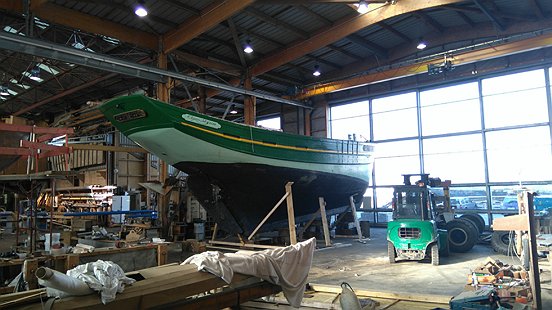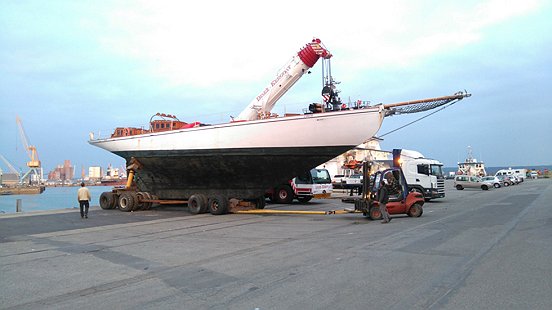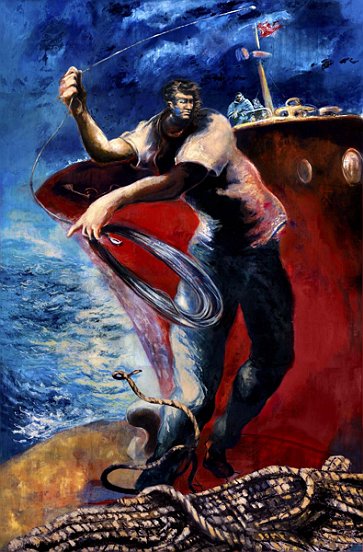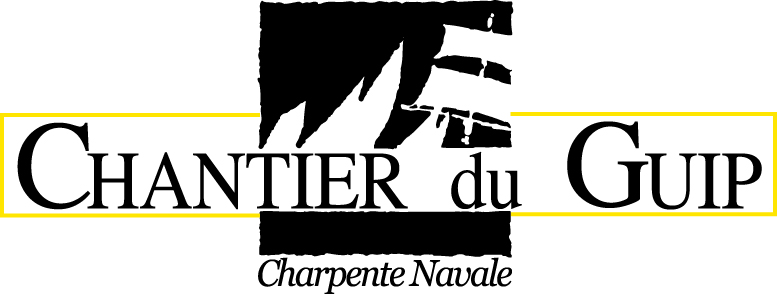
On 7 November the schooner Belle-Poule, sail-training ship of France’s military navy Marine Nationale, entered dock 19 of Brest’s former submarine base for a major refit. The aim of the refit is to maintain the excellent condition of this topsail schooner (32.45 m hull, 37.5 m LOA) built in 1932 at Fécamp (France).
A similar refit in 2015 included rebuilding the bridge deckhouse, replacing part of the navigation equipment, changing a generating set and the total refit of the engine room. As for the hull, various planks, stanchions, deck beams and deck planks were also replaced. Aloft, she got a new yard for the lower topsail and a new gaff for the mainsail.
All these numerous jobs were carried out by Guip Shipyard, the Navtis company, Marine Nationale’s logistics department and the crew.
For this year’s refit the works are, as ever, being directed by Guip boss Yann Mauffret and will focus on replacing an essential part of the boat, a major component of the ship’s backbone, the element that supports the stern, in other words, the sternpost! It is a very complex operation that has never before been attempted on a vessel of this size.
Indeed, the first thing to do is to remove the ‘whaleback’ deckhouse at the stern which, until the 1970s, was the radio operator’s room and, today, continues to protect the helmsman when the weather is poor. It also serves as the rest for the boom when the mainsail is furled, and is stowage for the emergency tiller, safety equipment and the access to the rudder gear.
With the whaleback gone, the next step will be to remove some of the deck planks, the copper sheathing on the stern planks, the stern planks themselves and the ceilings so the shipwrights can get to the rudder for the purpose of removing that too. In total, ten shipwrights will be on the job.
As for Navtis, Guip Shipyard’s partner in the contract for providing in-service support for the sailing ships and wooden vessels of Marine Nationale, they will take care of careening, painting, shipboard technology and engines.
By next March the pretty Belle-Poule will be back in the water and ready to pursue her task of training Marine Nationale’s officers and the students of France’s various naval academies.

Built in Audierne on the Raoulic Jetty in 1990 by the sailing trust of the same name and SCOP Navale from Douarnenez, the Cap-Sizun was one of many traditional boats launched for a competition organized by the magazine Chasse-Marée. She is a replica of the Lapart Bihen, one of the many lobster boats sailing out of Audierne which were known for their ‘hen-tail’ sterns.
Since the beginning the Cap-Sizun has been run by the volunteers of the sailing trust Bateau Cap-Sizun.
Today, the boat is 26 years old and, even if her general condition can be considered good, some maintenance works are required. These include changing the bulwarks, recaulking and resealing the seams between the deck planks, and replacing the hatches, the coachroof, the gaff and the jibboom.
Works will be completed by the spring and the Cap-Sizun will return to the water looking her very best. Not only that, but the thirteen bunks installed aft will allow her to continue offering sailing trips in the Bay of Audierne – and further afield – to keep alive the maritime heritage of Raz headland in Brittany.

Skeaf VII was for many years part of the fleet of Saint-Malo charter company Étoile Marine Croisière, run by Bob Escoffier. During that time she was known as the Étoile polaire and her elegant silhouette took part in many a sailing festival.
A gaff ketch with wood planks on iron frames, she was built in 1916 and bears the number DZ 906 797, ‘DZ’ referring to the maritime quarter of Douarnenez. Today she belongs to the sailing trust Skeaf which focuses on social integration through sailing.
Her life began on the stocks of the German shipyard Abeking & Rasmussen. She was delivered in 1916 to her first owner, Henri Horn, and he named her Skeaf VII. Confiscated in 1918 by Denmark as part of war reparations, she was subsequently renamed Eroika. In 1933 she became Gilnockie under her new British owner. Next, in 1969 a Canadian bought her and settled on Polaris, a name she would retain until 1995, the year she first came under French ownership.
The life of this yacht is worthy of a novel. In 1943, she had to beach on a mud-flat to escape the clutches of a German U-boat. In the late 1980s she sank in harbour and, severely damaged, was abandoned until her new French owner took her in hand and had her restored. In 2003, while being lifted out of the water, she was dropped and suffered serious damage. Already back then Guip Shipyard was contracted to rebuild her bow section.
This time, the works are a continuation of the 2003 rebuild and, in particular, Guip will be replacing all the other metal frames and floors, the two horn-timbers of the stern, and several hull planks. Work will also be done on the ballast and the engine compartment. Skeaf VII weighs 50 tonnes and her hull is 23 metres long (30 m LOA).

Anyone familiar with the commercial dock of Brest will have noticed that, since the renovation of the Grand Large building, the mural of the Waterman by Paul Bloas has disappeared from its prominent setting.
Paul Bloas is a well-known artist in Brest who came to prominence in the 1980s for his painted silhouettes, which were simple white contours, and later his impressive murals located in the disaffected parts of the great Breton port. Sites for these included the commercial dock, the Recouvrance quarter and, in particular, the Pontaniou Prison which closed in 1990. Respected all over the world, in the 1990s Bloas installed his massive characters in Berlin, Budapest, Bilbao and even Madagascar.
The cost of replacing the Waterman, estimated to be in the region of €40,000 euros, is too high for Brest City Council to assume; nevertheless, the council is encouraging the artist to find the financial support to bring the iconic portrait back to its original site. Which brings us to the general subscription.
Guip Shipyard is the first business in the Port of Brest to lend concrete support to Paul Bloas and his work of art which ‘is part of the cultural landscape of the port’.

